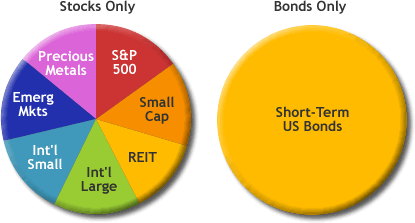(This is the fourth in my series of Model Portfolio Comparisons.)
I hope people aren’t getting overwhelmed by all of these portfolios. Remember, the law of diminishing returns applies to investment complexity as well. After a while, adding more asset classes and mutual funds doesn’t get you that much more expected return. If you’re getting bored, try some of the earlier portfolios and tune out the rest. Personally, I don’t mind having 8 funds or so, and I’ve found that after the initial setup the maintenance is pretty minimal.
William Bernstein, both a neurologist and a founder of his own money management firm, is the author of the challenging but information-packed book The Intelligent Asset Allocator (my review). Here is one model portfolio for those that desire moderate complexity and high risk. The author warns that while this asset allocation has very high expected long-term returns, it will behave much differently than the S&P 500 fund that many people use as benchmarks.
Bold Investor Model Portfolio

Asset Allocation for 70% Stocks/30% Bonds ratio
10% S&P 500
10% Small Cap
10% REIT
10% International Large
10% International Small
10% Emerging Markets
10% Precious Metals
30% U.S. Short Term Bonds
I think I’ve covered example mutual funds and ETFs for all of these asset classes except for precious metals in the other model portfolios, so I won’t repeat them here.
Possible Precious Metals Funds
streetTRACKS Gold Shares ETF (GLD)
American Century Global Gold Fund (BGEIX)
This asset allocation differs from some of the previous ones by having a larger percentage of stocks in international companies, as well as adding in precious metals exposure. I actually don’t remember seeing this mix when I first read IAA – it’s very interesting.
 The Best Credit Card Bonus Offers – 2025
The Best Credit Card Bonus Offers – 2025 Big List of Free Stocks from Brokerage Apps
Big List of Free Stocks from Brokerage Apps Best Interest Rates on Cash - 2025
Best Interest Rates on Cash - 2025 Free Credit Scores x 3 + Free Credit Monitoring
Free Credit Scores x 3 + Free Credit Monitoring Best No Fee 0% APR Balance Transfer Offers
Best No Fee 0% APR Balance Transfer Offers Little-Known Cellular Data Plans That Can Save Big Money
Little-Known Cellular Data Plans That Can Save Big Money How To Haggle Your Cable or Direct TV Bill
How To Haggle Your Cable or Direct TV Bill Big List of Free Consumer Data Reports (Credit, Rent, Work)
Big List of Free Consumer Data Reports (Credit, Rent, Work)
One aspect of Bernstein’s asset allocation is that he states that when determining your total mix you should include ALL your assets. That includes, cash, college funds, etc. If all your assets are included, and not just retirement, your percentage mix in a specific asset will be different. For example, if I include my emergency savings in my asset allocation and that boosts the total assets that I’m considering from $90,000 to $100,000 and I want to have 10% of my assets in S&P 500, I will have to boost my S&P500 from $9,000 to $10,000 otherwise I only have 9% of my assets in that specific class.
Any comments? Thanks!
Bernsteing’s portfolio looks very much like mine; his book is on my list to get to. I can’t invest in Gold in my 401K, but if I could I would invest the precious metals component in gold, because historically it is simply a more effective hedge. Since I can’t invest it in gold, I have it in Trsy Bonds. There is an advantage to the design of Bernstein’s portfolio that helps increase returns and lower risk.